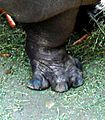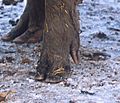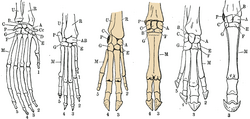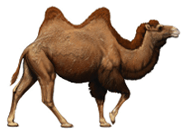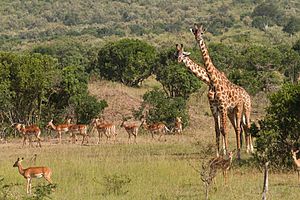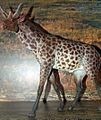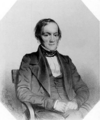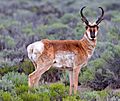Cetartiodactyla facts for kids
Quick facts for kids CetartiodactylsTemporal range: late Palaeocene - Recent
|
|
|---|---|
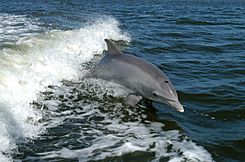 |
|
| Scientific classification | |
| Kingdom: | |
| Phylum: | |
| Class: | |
| Infraclass: | |
| Superorder: | |
| (unranked): |
Cetartiodactyla
|
| Orders | |
|
|
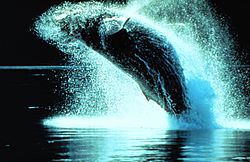
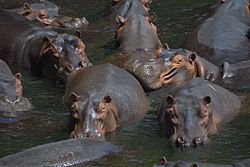
Cetartiodactyla The even-toed ungulates whose weight is borne equally by the third and fourth toes. By contrast, odd-toed ungulates, such as horses, bear their weight primarily on their third toes. The aquatic cetaceans (whales, dolphins, and porpoises) evolved from within even-toed ungulates, so modern taxonomic classification sometimes combines the Artiodactyla and Cetacea into the Cetartiodactyla.
The roughly 220 artiodactyl species include pigs, peccaries, hippopotamuses, whales, camels, llamas, alpacas, mouse deer, deer, giraffes, antelopes, sheep, goats, and cattle, many of which are of great dietary, economic, and cultural importance to humans.
Contents
Anatomy
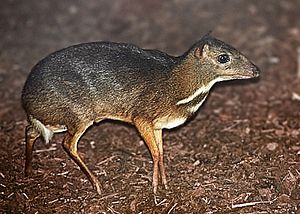
Artiodactyls are generally quadrupeds. Two major body types are known: Suinas and hippopotamuses are characterized by a stocky body, short legs, and a large head; camels and ruminants, though, have a more slender build and lanky legs. Size varies considerably; the smallest member, the mouse deer, often reaches a body length of only 45 cm (18 in) and a weight of 1.5 kilograms (3.3 lb). The largest member, the hippopotamus, can grow up to 5 meters (16 ft) in length and weigh 4.5 metric tons (5.0 short tons), and the giraffe can grow to be 5.5 meters (18 ft) tall and 4.7 meters (15 ft) in body length. All even-toed ungulates display some form of sexual dimorphism: the males are consistently larger and heavier than the females. In deer, only the males boast antlers, and the horns of bovines are usually small or not present in females. Male Indian antelopes have a much darker coat than females.
Almost all even-toed ungulates have fur, with an exception being the nearly hairless hippopotamus. Fur varies in length and coloration depending on the habitat. Species in cooler regions can shed their coat. Camouflaged coats come in colors of yellow, gray, brown, or black tones.
Limbs
Even-toed ungulates bear their name because they have an even number of toes (two or four) – in some peccaries, the hind legs have a reduction in the number of toes to three. The central axis of the leg is between the third and fourth toe. The first toe is missing in modern artiodactyls, and can only be found in now-extinct genera. The second and fifth toes are designed differently between species: in the hippos, they are directed forward and fully functional; for the other even-toed ungulates, they face backwards or are completely reduced. For pigs and deer, the toes are still in contact with soft, muddy ground and increase the contact surface area. In most cases, however, they no longer touch the ground. In some groups, like the camels and giraffes, regression has progressed so far that the second and fifth toe are not even present.
When camels have only two toes present, the claws are transformed into nails (while both are made of keratin, claws are curved and pointed while nails are flat and dull). These claws consist of three parts: the plate (top and sides), the sole (bottom), and the bale (rear). In general, the claws of the forelegs are wider and blunter than those of the hind legs, and the gape is farther apart. Aside from camels, all even-toed ungulates put just the tip of the foremost phalanx on the ground.
In even-toed ungulates, the bones of the stylopodium (upper arm or thigh bone) and zygopodiums (tibia and fibula) are usually elongated. The muscles of the limbs are predominantly localized, which ensures that artiodactyls often have very slender legs. A clavicle is never present, and the scapula is very agile and swings back and forth for added mobility when running. The special construction of the legs causes the legs to be unable to rotate, which allows for greater stability when running at high speeds. In addition, many smaller artiodactyls have a very flexible body, contributing to their speed by increasing their stride length.
Head
Many even-toed ungulates have a relatively large head. The skull is elongated and rather narrow; the frontal bone is enlarged near the back and displaces the parietal bone, which forms only part of the side of the cranium (especially in ruminants).
Horns and antlers
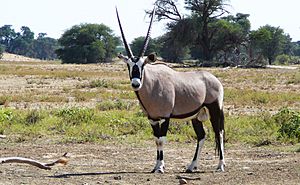
Four families of even-toed ungulates have cranial appendages. These Pecora, (with the exception of the musk deer), have one of four types of cranial appendages: true horns, antlers, ossicones, or pronghorns.
True horns have a bone core that is covered in a permanent sheath of keratin, and are found only in the bovids. Antlers are bony structures that are shed and replaced each year; they are found in deer (members of the family Cervidae). They grow from a permanent outgrowth of the frontal bone called the pedicle and can be branched, as in the white-tailed deer (Odocoileus virginianus), or palmate, as in the moose (Alces alces). Ossicones are permanent bone structures that fuse to the frontal or parietal bones during an animal's life and are found only in the Giraffidae. Pronghorns, while similar to horns in that they have keratinous sheaths covering permanent bone cores, are deciduous.
All these cranial appendages can serve for posturing, battling for mating privilege, and for defense. In almost all cases, they are sexually dimorphic, and often found only on the males.
Senses
Artiodactyls have a well-developed sense of smell and sense of hearing. Unlike many other mammals, they have a poor sense of sight – moving objects are much easier to see than stationary ones. Similar to many other prey animals, their eyes are on the sides of the head, giving them an almost panoramic view.
Lifestyle
Distribution and habitat
Artiodactyls are native to almost all parts of the world, with the exception of Oceania and Antarctica. Humans have introduced different artiodactyls worldwide as hunting animals. Artiodactyls inhabit almost every habitat, from tropical rain forests and steppes to deserts and high mountain regions. The greatest biodiversity prevails in open habitats such as grasslands and open forests.
Social behavior
The social behavior of even-toed ungulates varies from species to species. Generally, there is a tendency to merge into larger groups, but some live alone or in pairs. Species living in groups often have a hierarchy, both among males and females. Some species also live in harem groups, with one male, several females, and their common offspring. In other species, the females and juveniles stay together, while males are solitary or live in bachelor groups and seek out females only during mating season.
Images for kids
-
Richard Owen coined the term "even-toed ungulate".
-
The mesonychids were long considered ancestors of whales.
-
Camels are now considered a sister group of Artiofabula.
-
The pronghorn is the only extant antilocaprid.
-
Reconstruction of Indohyus
-
Blue duiker (Philantomba monticola) skeleton on display at the Museum of Osteology.
-
The Japanese serow has glands in the eyes that are clearly visible
-
Most artiodactyls, such as the wildebeest, are born with hair.
-
Some artiodactyls, like sheep, have been domesticated for thousands of years.
-
The aurochs has been extinct since the 17th century.
See also
 In Spanish: Artiodáctilos para niños
In Spanish: Artiodáctilos para niños


